A set of concentration exercises, known as "The Original Five Tibetan Rites of Rejuvenation" has been published in the western world by Peter Kelder in 1939. Due to unprecedented effectiveness of these simple concentration exercises (which I have also verified myself) Peter Kelder' book has been published again (Peter Kelder, The Eye of Revelation - The Original Five Rites of Rejuvenation, Borderland Sciences Research Foundation, 1989, ISBN 0-945685-04-1). Below is my summary of these exercises.
According to Tibetan Lamas, these exercises aim to
Even if only a part of above aims is achieved, the impact of these exercises seems to extend far beyond their physical benefits.
The most important in all Tibetan exercises described below seems to be a conscious synchronisation of breathing with physical activity. For best results, I strongly advise anyone to practice basic 4 stage breathing techniques ( inhale, hold, exhale, hold empty lungs) before trying Tibetan Rites.
The other important advice, passed on by ancient Lamas and verified by modern medical science is that no exercise at any stage should be too intense or make us feel exhausted. This advice applies not only to The Five Tibetan Rites presented below, but to any physical exercise.
If the intensity of the exercise is excessive, not only such exercise is not beneficial, but may even be harmful. If you are "loosing your breath" for example, it is a sign that the body has entered an anaerobic (low oxygen) emergency mode of operation and it is a fair warning from your body and mind that you should slow down.
One method of assessing the right level of physical activity for you is to observe your pulse rate. If it exceeds 90-100 - you should slow down. Another good gauge is this: if you feel comfortable continuing the exercise (Tibetan, yoga, jogging, walking, skating, roller skating, tennis etc.) over long periods of time without strain, this level of activity is right for you. Note, that with training you can increase the intensity of exercise. After exercising at the right intensity you should not feel tired. On the contrary, you should be more energetic and, most importantly, have clearer, sharper mind. We should enjoy whatever we do, shouldn't we?
Applying the above advice to Five Tibetan Rites, you should not get too enthusiastic about overdoing them. Although they are very simple, the main emphasis should be on breath synchronisation and fluency, rather than on speed and/or number of repetitions.
Tibetan Lamas recommend starting with 3 repeats and gradually building strength and skill to reach 21 repeats. Performing more than 21 repeats, according to Lamas, is redundant and therefore not necessary.
All motions in the following Five Tibetan Rites need to be fluent, with depicted positions held between the motions as shown in the following diagrams. Please note breathing phases.
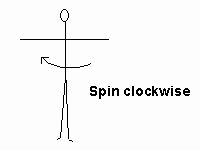
Tibetan #1
Stand straight and stretch your arms to the sides. Spin clockwise standing at one spot. The most important, apart from the clockwise direction of spin, is to make sure that you stop before feeling dizzy and getting any difficulty with your balance. Choose carefully the speed and the number of full rotations (up to 21) which do not make you dizzy. Gradually with practice, you should be able to spin full 21 times and also increase the speed without getting dizzy. Children do this exercise spontaneously and they have plenty of energy.
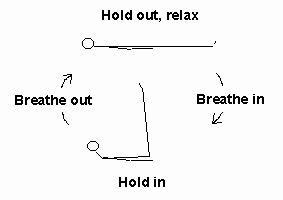
Tibetan #2
Start stretched on your back with your hands along the body, palms of your hands on the floor, fingers together. Raise your head and legs gradually while breathing in. Your legs should be straight, straighten them as much as you can. Tuck your chin against the chest. After holding the position with raised legs and head, lower them gradually while breathing out. Then relax your muscles before repeating the cycle. Keep a breathing rhythm so that all four phases of this exercise are approximately of the same duration. If you need to miss a cycle because you need a rest, keep breathing in the same rhythm and wait for the entire breathing cycle before starting again. Maintaining the rhythm is important.
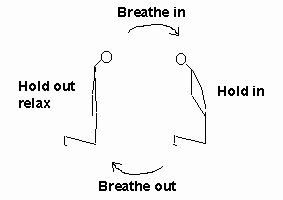
Tibetan #3
Lamas recommend exercise #3 to be practiced immediately after the exercise #2.
Kneel on the floor, hands on thigh muscles. Tuck the chin against the chest, breathing out. Then arch back as far as you can bracing your arms against your thighs while breathing in. When you return to the original position, breathe out, relax and start the cycle over again.
Lamas practice this exercise with eyes closed, focusing inward for best effect.
Deep breathing and maintaining rhythm is important. Keep a breathing rhythm so that all four phases of this exercise are approximately of the same duration.
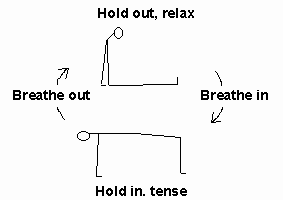
Tibetan #4
Start sitting down on the floor, legs straight, feet 30 cm (12 inches) apart, palms of your hands on the floor alongside your buttocks. Tuck the chin against your chest, breathing out.
Then arch your head back and lift your body so that the knees bend and your arms remain straight while breathing in. Aim to achieve the horizontal position of the body as indicated in the figure above and maintain it by tensing every muscle in your body. Then exhale while returning to the original sitting position. Your hands and feet should remain at the same location on the floor. Relax with your chin down and start the cycle over again.
This exercise may seem to be initially more difficult than others. If you cannot do it at first, continue with other exercises, trying your best with this one every time. Gradually, Tibetan #4 should become as easy as others. Keep a breathing rhythm so that all four phases of this exercise are approximately of the same duration.
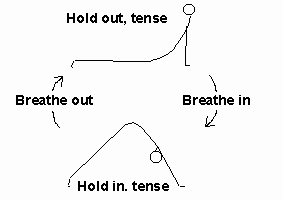
Tibetan #5
In this exercise hands and feet should be spaced slightly wider than your shoulders.
Start in a sagging position, your spine arched back, hands perpendicular to the floor, feet on the toes, head as far back as possible, breathe out. Your body should be close to the ground, but not touching it.
While breathing in and keeping your legs and arms straight, raise your body as high as you can, as depicted above. Then breathe out returning to the original position. Tense your muscles at each position.
Keep a breathing rhythm so that all four phases of this exercise are approximately of the same duration.
The series of Five Tibetan exercises described here can be practiced two or three times a day everyday during the entire lifetime. In contrast, the following exercise, according to Lamas, has a very special purpose and it should be practiced only in circumstances described below. If you are not sure, and do not practice the first five exercises regularly, do not practice this exercise. You have been warned.
The purpose of the Tibetan #6 exercise is to redirect the excess of sexual and reproductive energy, generated by the activity of the base chakra to all higher chakras along the spine, especially to the brow chakra, which activity is related to our spiritual awareness and psychic abilities. According to Lamas this exercise should be practiced only when the excess of the sexual urge is experienced, otherwise this exercise does more harm than good, by draining the energy from the base chakra.
By systematically practising the first five Tibetan exercises it is quite possible to raise the energy of the base chakra so much, that the sexual urge appears and needs to be dealt with. This can happen at any age.
One way to handle the situation is to dissipate this powerful energy in sexual activities. The Tibetan alternative is to transmute it to higher use, to accelerate our spiritual development and rejuvenate the body. Instead of dissipating the reproductive energy you can use it to regenerate cells in your entire body. The choice is yours, you have the free will, as always.
In my opinion, sexual activity without sincere love and a spiritually matched partner is like going to a forest and not seeing trees. Or enrolling at a University just to have lunch in the canteen.
Sexual love should be a spiritual union, bringing experiences and sensations far more profound, pleasurable, longer lasting and beneficial than just a physical act of relief (see The Book).
In the absence of a perfect partner, Tibetan Lamas offer us the alternative, verified over many thousands of years to be not only effective, but also very beneficial to our health, longevity, bio-energy level and most importantly to our spiritual development. They do not try to suppress the powerful energy of the base chakra. Such suppression is destined to fail, much as any act against the Nature. They offer an efficient way to transmute it for the higher purpose.
Tibetan #6 differs in many ways from all of the previously described Tibetan exercises. Firstly, it is one of the easiest to perform from the physical body motion point of view, not requiring any diagram. Secondly, it involves a special breath control, requiring a prolonged holding of the breath, rather than breathing rhythmically. The third difference is that after each cycle of Tibetan #6 several cycles of deep breathing are required. Another difference is that no more than three repeats are recommended for most people.
The sequence of Tibetan #6 is as follows: